Battle of Murten: costly arrogance
Battle of Murten. Panorama of Ludwig Brown. "The Burgundian camp, attacked."
Siege of Murten
And it was that, having barely recovered from the defeat of Granson, Karl the Bold once again decided to get involved in a fight with the Swiss and, having gathered new forces, he already in June 1476 of the year invaded their territory. Already on June 9 his army laid siege to the fortress of Murten just 25 kilometers from Bern. It would be more logical to go to Bern itself, but Karl apparently decided not to leave an enemy garrison in his rear, so for the beginning he decided to take Murten. The city was defended by the garrison in 1580 fighters, so the seemingly serious resistance to the army of Karl, armed with powerful artillery, was not supposed to be!
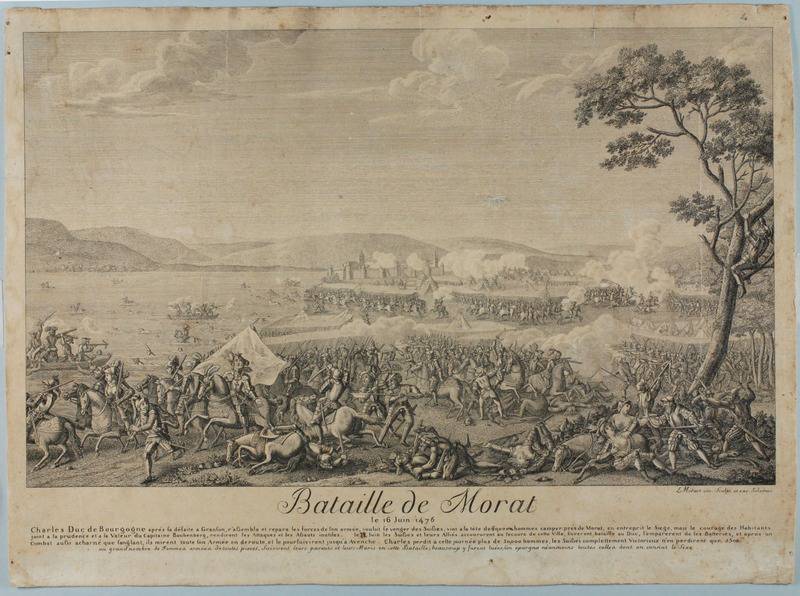
Engraving on 1879-80, depicting the battle of Murten. Louis Midart. The funds of the Central Library of the city of Soloturn.
The Burgundians began by pouring a rampart around Murten, then putting bombers on it, reinforcing the gaps between them with a palisade and began to burn them along the city walls. That is, they did the same as Julius Caesar did in his time near the walls of Alesia: a control line was built around the besieged fortress, installing artillery on it, and in the case of the approach of Swiss troops in 1,5 - 2 km from the city built a circular distribution line (though solid it was not), defending their army outside. After that, 12 June they went to the assault, but he was recaptured, as reinforcements arrived on the lake to the garrison of the fortress. Karl understood that Swiss troops were about to come to Murten’s help. Therefore, he did not re-attack the fortress, but confined to shelling, and began to prepare for battle with the enemy. The Burgundians spent several days in alarm, expecting that the Swiss were about to come. An alarm was declared several times, and the army was built behind a palisade to repel the attack of the enemy, but the Swiss did not appear, and the Burgundians again returned to the camp. 21 June Carl personally made a reconnaissance of the location of the Swiss and considered that they were not going to attack him.
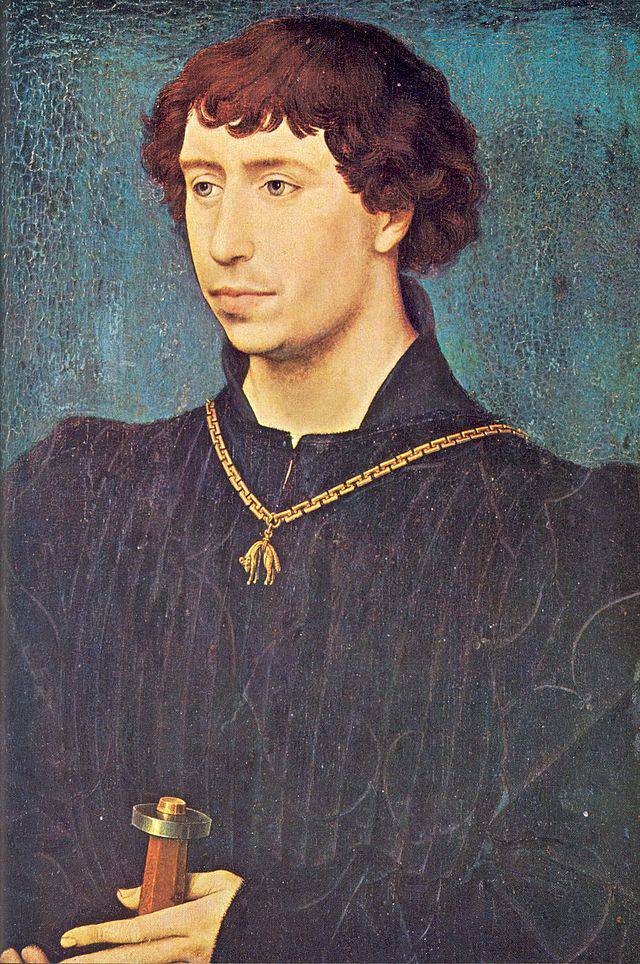
Karl the Brave (Karl Daredevil), Duke of Burgundy (1433-1477). Roger van der Weyden painting (approximately 1460 year).
And what did the Swiss do?
After learning about the actions of the enemy, 10 June Bern announced mobilization. As early as June 11, the Berne units began to arrive at border points and the very next day they began to engage in clashes with the Burgundians. On Wednesday, June 19, the Bernese militia (5-6 thou. People) camped at Ulmitsa, just a distance of 5 km from the forward positions of the Burgundian troops. The militia of their allies also began to approach here: the Basel militia (from 2 000 manned infantry and 100 cavalrymen) and the cavalry from Alsace under the command of Duke Rene of Lorraine and Oswald von Tirstein, who was an assistant to the Upper Alsace Bali.
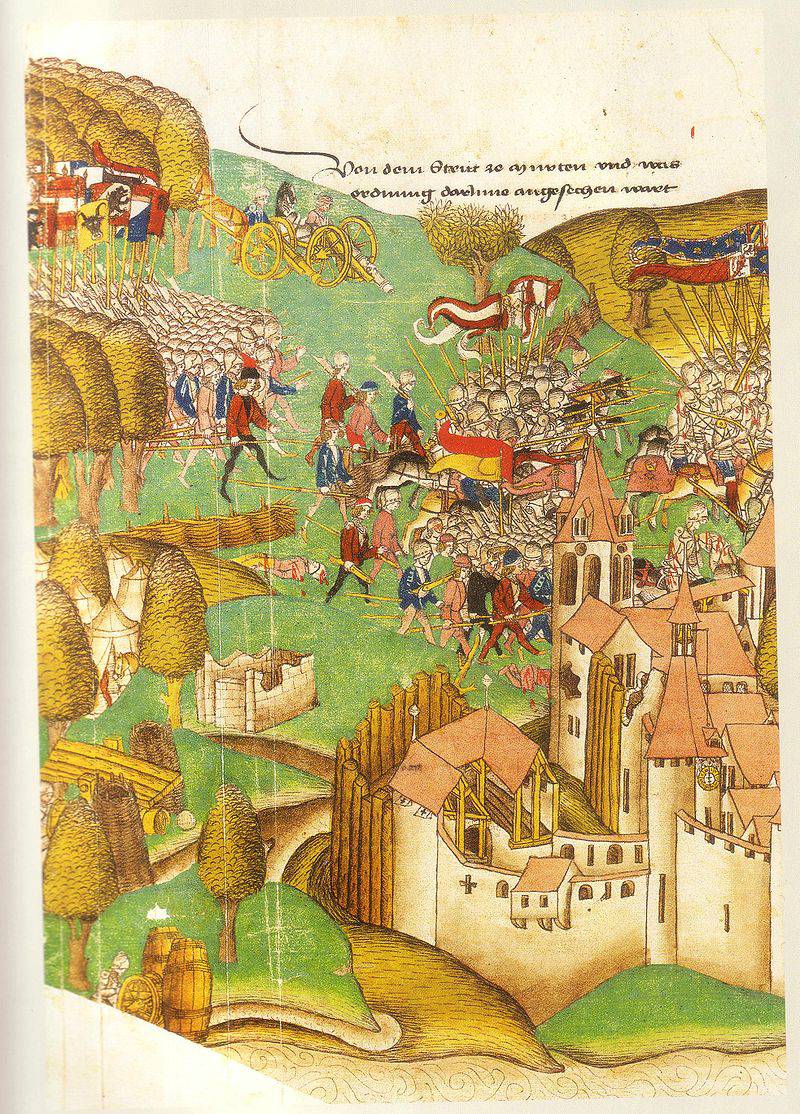
Battle of Murten. Miniature from the Lucerne Chronicle of Schilling the Younger 1513 of the Year. Zurich Library.
In total, according to one of the participants of the battle, Jörg Mollbinger, who fought in the noble cavalry, here turned out to be 26 000 allied forces, of which more than 1 800 were horsemen. Hans von Kahenek, another member of this battle, who also fought in cavalry, names a smaller number - 1100 riders.
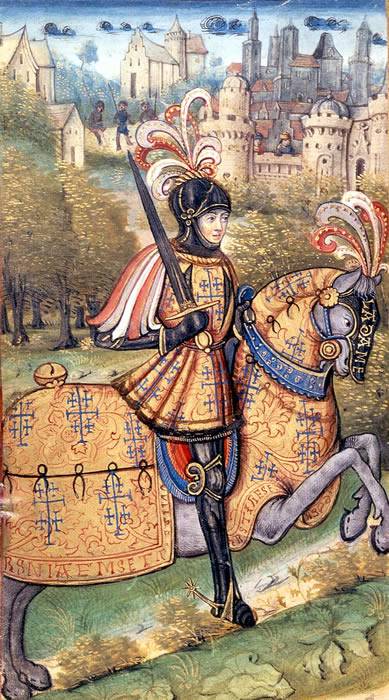
Rene II, Duke of Lorraine. Lorraine Museum.
The vanguard of the Swiss was commanded by Hauptmann Hans von Gollville of Aargau. It included arrow-crossbowmen and also cooler printers, and half were pikemen. The total number of avant-garde reached 5 000 people. Kagenek wrote that there were “Bernians, Friburs and Schwyzians” in it.
Milan helmet 1440. Weight 4196. Metropolitan Museum, New York.
The main forces (Gewalthaufen), commanded by several Hauptmans, among whom Hans Waldmann stood out, were a “battle” in the form of a “spear” or “hedgehog” with pikemen along the whole perimeter of the 4 line, and arrows in the center. The battles ranged from 10 to 12 thousand people.
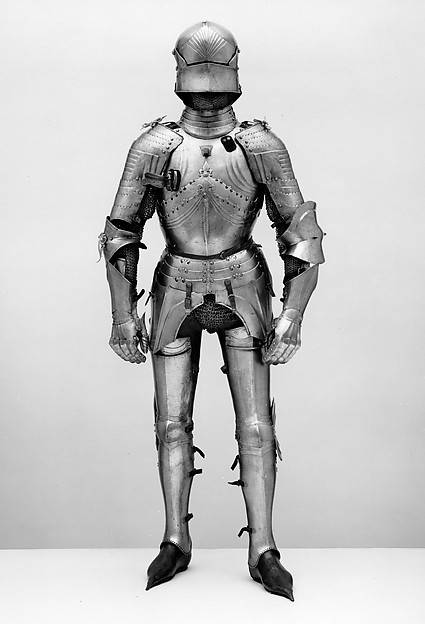
1480 armor of the year. Metropolitan Museum, New York.
The rearguard (nahhut) was commanded by Hauptmann Caspar Gartenstein from Lucerne. It was 5-6 thousand fighters, armed about the same. Between the vanguard and the main battle the cavalry moved.
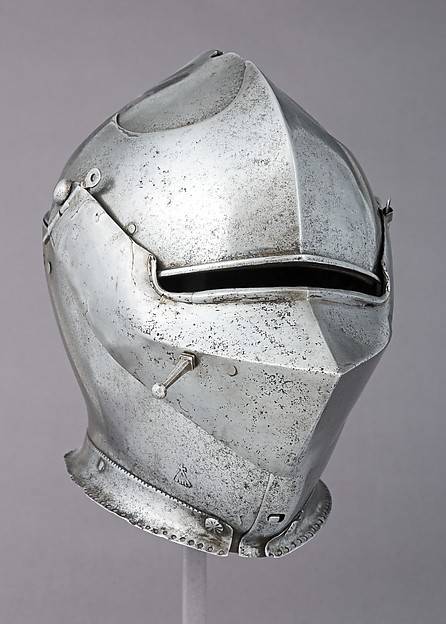
1475 Helmet; Weight 3374; Metropolitan Museum, New York.
Meanwhile, it began to rain, from which the allies had nowhere to hide. In addition, the Zurichs were waiting, and they came at night, although they were exhausted by an incredibly difficult road. Immediately they gathered a military council and entrusted the general command of Wilhelm Herter von Gertenegg, who became the "chief Hauptmann."
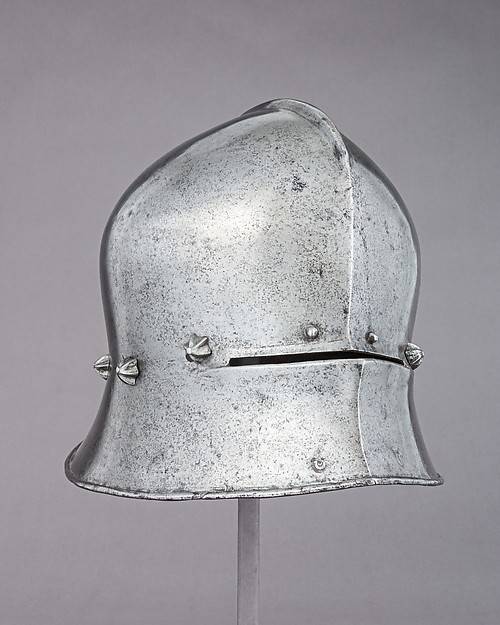
Helmet 1475 Sallet Propulsion 2778 Metropolitan Museum, New York. The development of iron-making production at that time allowed mass production of similar armor and, in particular, sallet helmets, which were used by Swiss infantry and Burgundy. Since the armor was similar, it was necessary to sew multicolored crosses on the clothes for identification.
On Saturday early in the morning reconnaissance was carried out. 500 mounted horse gendarmes and 800 infantrymen under the command of Gerter and Waldmann went to the positions of the Burgundians. They reached the Burgundian positions, but then moved back under artillery fire. Nevertheless, they managed to examine both the barrage built by the Burgundians and the location of their artillery.
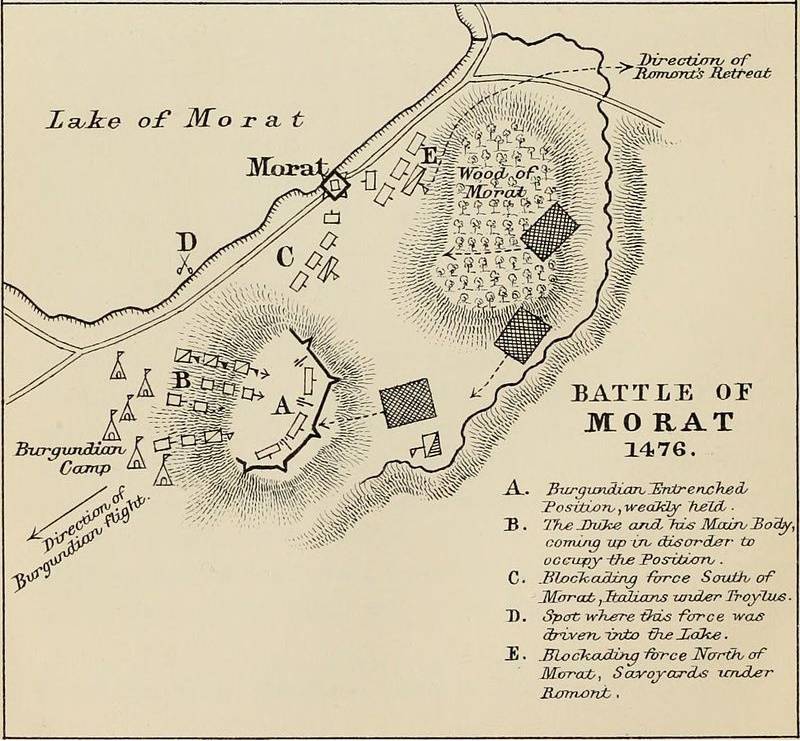
Map of the battle.
The battle itself began shortly after noon. Petermann Etterlin, one of the Hauptmann commanders of the Swiss avant-garde, later wrote in his "chronicles" that they were going hastily, and many of the soldiers did not even have time to have breakfast. That is, even then they slept a long time and ate late, although it was possible that this was due to rain and the late approach of the Zurich militia. Whatever it was, the Allies lined up and left the camp, but they did not even go one kilometer, they stopped at the edge of the forest, lined up in a battle, and then Oswald von Thirstein did what Rene Lorraine did and more 100 nobles knighted. So to say, raised their morale, because to die a knight is not at all that just to die ... "a rich landowner"!
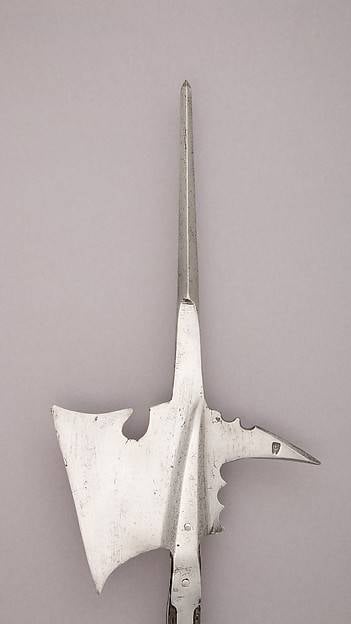
Swiss halberd weighing 2320 Metropolitan Museum. New York.
The course of the battle
After that, the Swiss infantry, reinforced by cavalry troops of the dukes of Lorraine and Austrian, began an attack at the very center of the position of the Burgundians under the din of the drums. And it was here that it turned out that there was no intelligence from Karl the Brave! He, you see, did not expect their attack, since it had rained heavily the day before. Like, the roads will be difficult, and if so, then the Swiss will not be able to approach the city. The fact that the enemy could walk in the fields, on the grass and on the routed roads would not stop him, somehow it simply did not occur to the brave duke, but he did not guess to send scouts.
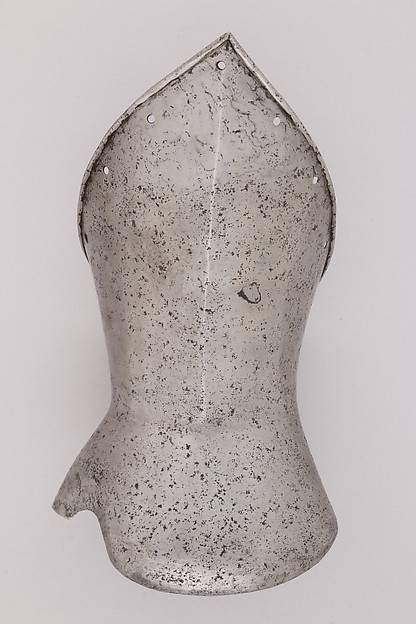
Plate gauntlet 1450 Italy. Weight 331.7 Metropolitan Museum, New York.
The battle formation of the Swiss consisted of three battles of spearmen and alebardis, between which there were knights (at least 1 thousands of 800 people) and arrows. In the first line there were two battles and horsemen, in the second one. And the attack of the Swiss turned out to be completely unexpected for the Burgundians. Moreover, Karl himself was distrustful of the report of his escort, so he did not immediately give the order to declare a combat alarm, because of which a lot of time was lost, so precious in any battle.
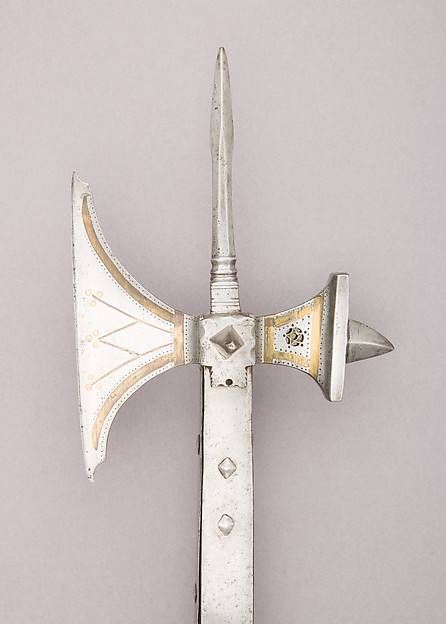
Burgundy Pollex. Weight 2976.7 Metropolitan Museum, New York.
Nevertheless, the Burgundians were able to open heavy fire from their bombards and small cannons and were able to thwart the attack of the Swiss. But they were not scared at all, but came out from under artillery fire, turned around at 180 degrees, rebuilt and ... just changed the direction of the attack. All this perfectly describes the high combat skills of the Swiss and their discipline, and at the same time shows the low level of martial art of Karl the Bold and his entourage. Still, rebuilding in front of the enemy and close to him is a dangerous business. After all, Karl could (and should in theory!) Send his gendarmes to attack.
Battle of Murten. Panorama of Ludwig Brown "Attack of the Lorraine and Austrian cavalry."
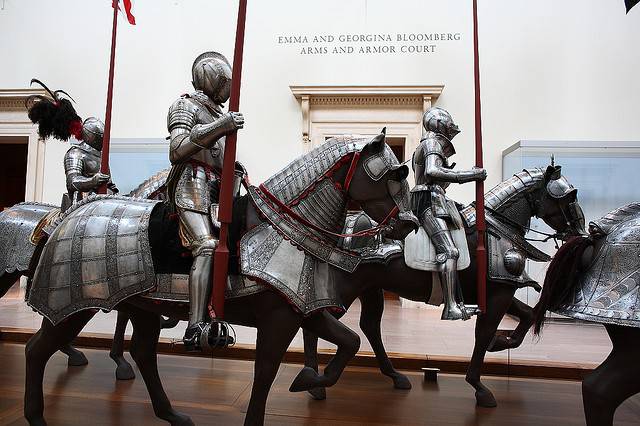
The gendarmes of the XV century. Metropolitan Museum, New York. The armor by this time had become so strong and perfect that the need for riders' shields disappeared.
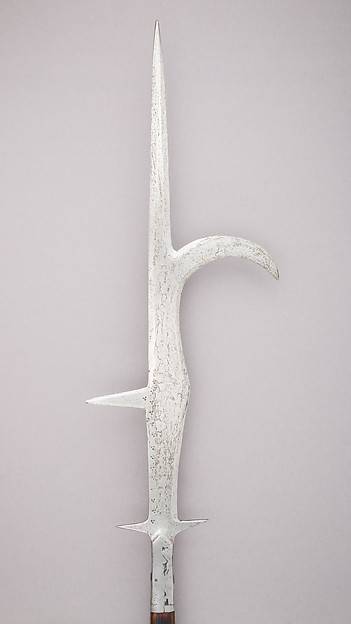
Guizarm 1490. Weight 2097.9. Metropolitan Museum, New York.
However, he did not do this, and the rebuilding itself took place so quickly that the Burgundians could neither refocus their artillery fire on them, nor build their own forces into battle order. As a result, a very heavy blow was dealt to the troops of Charles, which they could not stand. But here, seeing what was happening from the walls of the besieged Murten, his garrison opened the gates and hit the rear of the Burgundian army. Here again the question arises: how much did the Burgundian bombers not aim at the city gates? Well, just in case ?! Where were the gunmen of the siege bombardment, from which literally just fired at the city? After all, it was obvious that in the event of an attack “from the field,” the garrison would necessarily go on a sortie? But, apparently, it was all for Carl the Bold that it was just not obvious why everything happened that way, and not otherwise. As a result, in his army only those killed were from 6 to 8 thousands, and the duke himself shamefully fled from the battlefield. Moreover, a significant number of English archers hired by him fell into the number of the fallen, and the mercenaries do not like such a command, and such losers are usually not hired anymore.
Battle of Murten. Panorama of Ludwig Brown "The Burgundy Camp and the English Archers".
Battle of Murten. Panorama of Ludwig Brown. "The flight of the army of the Burgundians".
Thus, the battle of Murten once again demonstrated the high fighting qualities of the Swiss infantry. Skillfully using the terrain, she using a gunshot weapons could successfully repel attacks even knightly cavalry. In hand-to-hand combat, due to her halberds, she had a number of advantages over infantry with long peaks.
"Karl the Bold flees after the Battle of Murten." Eugene Bournand 1895
The same picture, presented in the form of a picture in the magazine "Niva". Yes, then, in order to see the pictures in color, one had to travel. Now enough to get on the Internet.
Interestingly, this battle inspired the German battle of Ludwig Brown to create a panorama of the Battle of Murten 1476, which he wrote in the 1893 year. This really huge 10 canvas on 100 m is impressive at the same time with its colorful and wide scope. True, it was written in the "romantic style", because of which the depicted individuals are excessively dramatized, and the composition looks somewhat staged. But be that as it may, this is a true work of art.
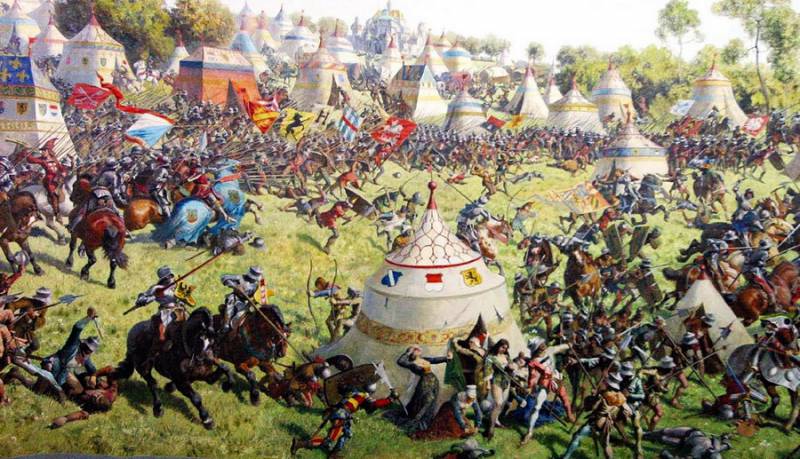
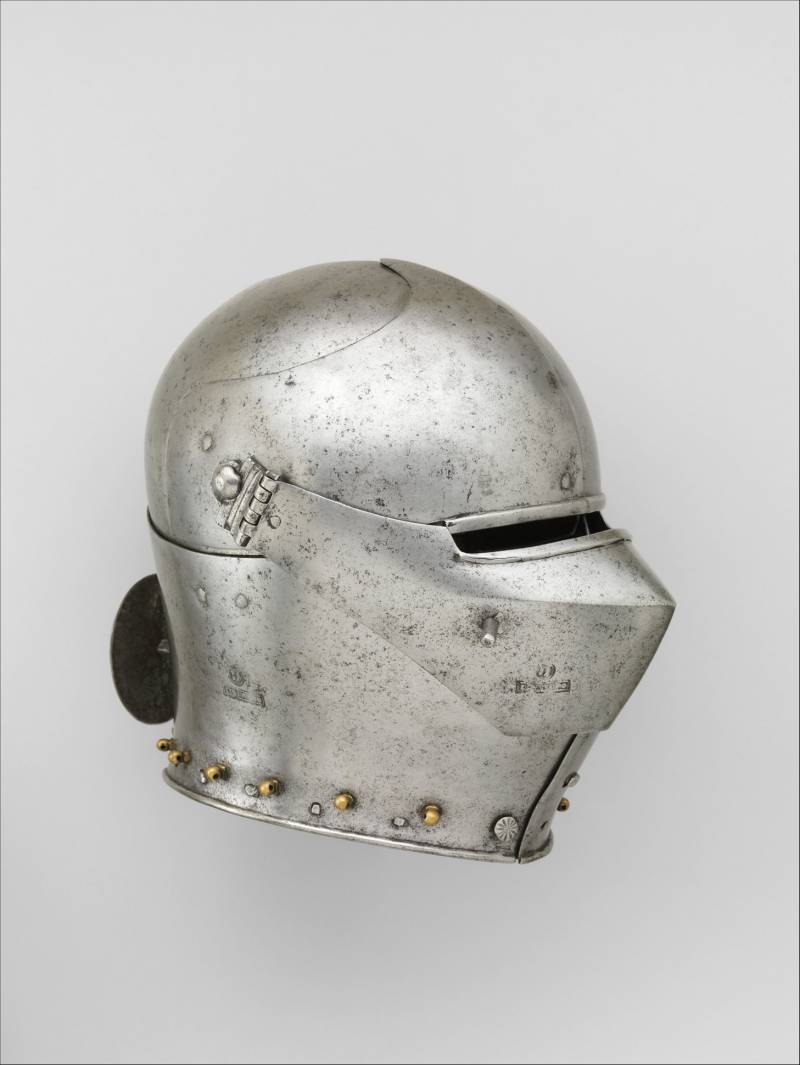
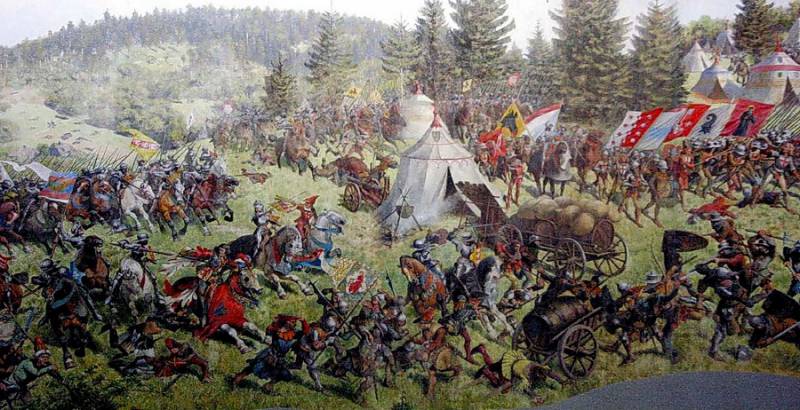
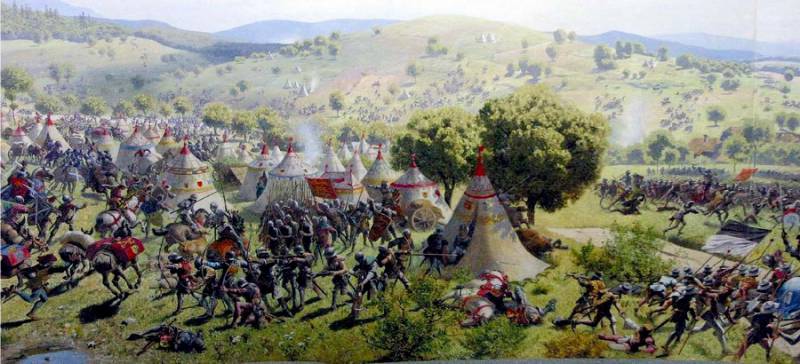
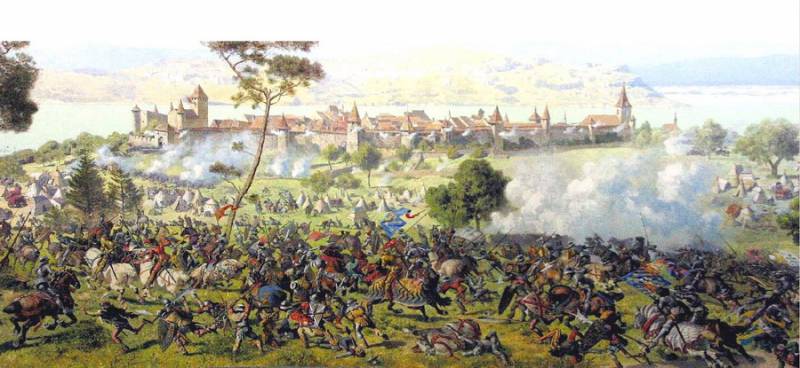
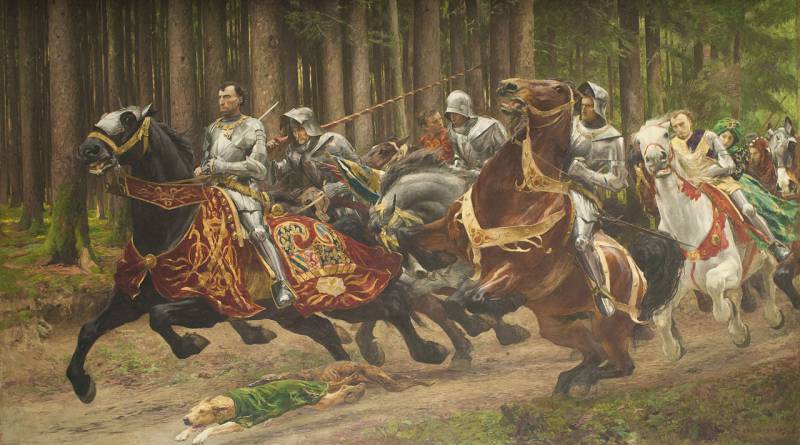
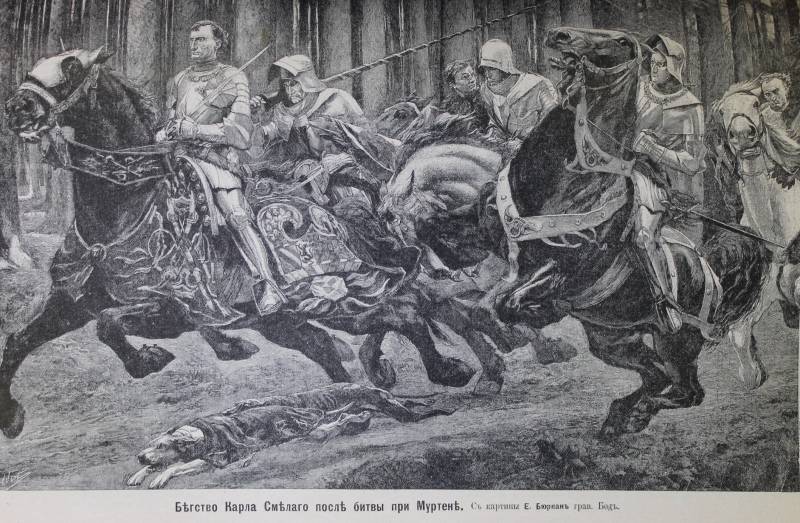
Information